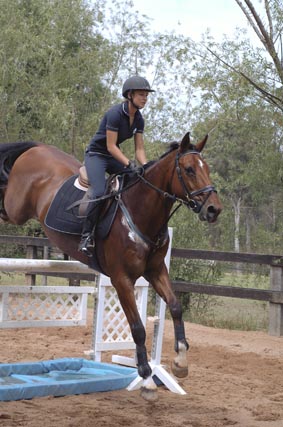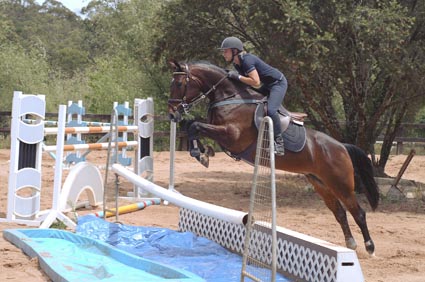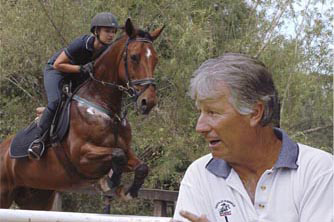
Missed part one? It’s here. Part two is here Part three is here
This month, George Sanna applies himself to what is often the most exciting jump in any course – the Water…
“Liverpools are really in themselves distractions, they are not jumps that in themselves – like verticals or oxers – need to be ridden in a certain way. Liverpools either have a vertical in front of them, or they have a vertical on the back side of them – or they go under an oxer. If the horse is absolutely unconcerned by the water element, then you don’t need to ride that jump any differently from any other oxer or vertical.”
“But some horses have a natural aversion to the look of the water. Liverpools get some horses looking down – or sometimes horses absolutely refuse to go near the jump. Even the horses that are normally pretty good with water, it gets them looking down and being distracted, so they are more likely to have a fault.”
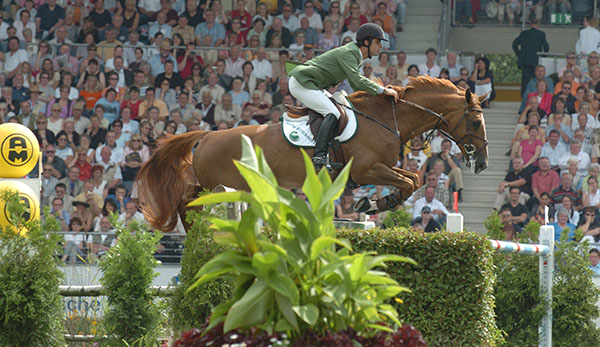
“If you ride a metre thirty vertical there is a certain ride that is ideal for that jump. You put a Liverpool underneath it, if you are riding a very very confident horse that has seen a million Liverpools and doesn’t give a toss about them, you just ride it the same as any metre thirty vertical. But if you are riding a horse with a severe aversion to water, you’ve got to have way way way more forwardness, connection, activity, power, strength – everything. You can’t just come with a sweet soft ride and expect him to jump the jump. At best he is going to hesitate off the ground and at worst he is going to stop five strides away and spin around and run in the other direction. Then, of course, the stronger ride, which is not the appropriate ride for a metre thirty vertical will end up getting you to the other side of the jump, but you might have it down in the process.”
story continues below advertisement

What causes that severe reaction to water – bad training, bad riding, genetics?
“In some cases bad training. If you go to a show and your horse has never seen a Liverpool before, then that is bad training. Your horse gets scared, crashes through it, and develops an issue with Liverpools – that is clearly bad training. It is your job to make sure he is familiar with all the obstacles he is going to see at a show in a training situation, otherwise you are not properly prepared.”
“Horses when they first start will jump a rustic pole, I’m talking about a cautious, careful horse, he’ll pop over a rustic pole, he might look a bit more at a painted pole. You put a plank underneath that, and he is already looking a bit – he pops it a few times, and he gets comfortable. Then the first wall he sees, or the first gate that he sees, each time you work through it. And some horses find some things more spooky than others. And some horses are much spookier than others.”
“You set up Liverpools at home, and you jump them, and you jump them, and you jump them, until your horse realises that there is really nothing about them that is scary.”
What about if you get a horse that is really aversive – I think you had that with Cadbury didn’t you?
“Open water, that was his issue.”
What’s the deal with open water?
“Most horses have an initial fear of the Liverpool concept – whether it has water in it or not, just a big blue thing under the jump – I don’t think the water actually adds or subtracts a whole lot to it, apart from a little shimmer occasionally if they are really looking for something that might add to it. It’s just that big blue thing that is scary.”
“With open water it’s again a matter of the canter, it has no height element, it only has a spread element and so your canter has to have a lot of ground speed and length – you need to meet it ideally on an ascending stride and get as close as you can to the front of it. When I say close as you can, not in a way that the last stride totally interrupts the horse’s forward movement, but on an ascending stride right up to the base of the little wall or brush or whatever they have there.”
“Ideally the horse is on an increasing stride, jumping out – whereas our ideal vertical ride, will be on a slightly decreasing stride. The ideal ride to the vertical is to slightly compress to it, the oxer is pretty even, slightly forward maybe but to a deeper distance, and to the open water, for sure that should be a moving up stride.”

Is it a problem of access, that people in Australia don’t get to ride over open water all that often?
“Sure, I think a lot of horses, the first time they see open water is at a show. The professional riders don’t do that – but there is certainly plenty that do, and it becomes the beginning of a lifetime of bad water jumping.”
“The important thing with jumping any jump, is that you have got to come through the turn to that jump with pretty much the pace that you want to jump that jump from. So that if your distance ends up being a waiting distance, you are not far above your ideal pace – and if your distance ends up being a moving up distance, again you are not far below the ideal pace for that jump – and if your distance is pretty much good, then that is perfect. So when we talk about the ideal pace, as we did with verticals and oxers, if we have exactly the right pace through the turn, that allows us to slow that pace a little for a shorter distance, or to move it up a bit for a longer distance, and still be in a comfortable zone.”
“When we come to any jump mathematically we have one of three alternatives, either the distance comes up a little short, or a little long, or about right. If we come too forward through the turn to a vertical and we only see a forward distance, then we are going to knock it down because we are already at the top end of the ideal range, and then we increase from that – the horse is going to get long and flat. Accordingly if we come through the turn to the oxer and we are too slow, and we see only a waiting distance – then the horse loses power, loses his forwardness, and he is likely to get up in the air and land on the back rail.”
“With water that is equally the case. “We need to come through the turn with the pace we want to jump the water, because it is possible that even though we are desperately wanting to catch a forward distance, it just might not be the distance that is there. We’ve got to have enough early pace, that if we take a little off the pace, we’ve still got the pace to get to the back rail. So early pace is critical.”
story continues below advertisement
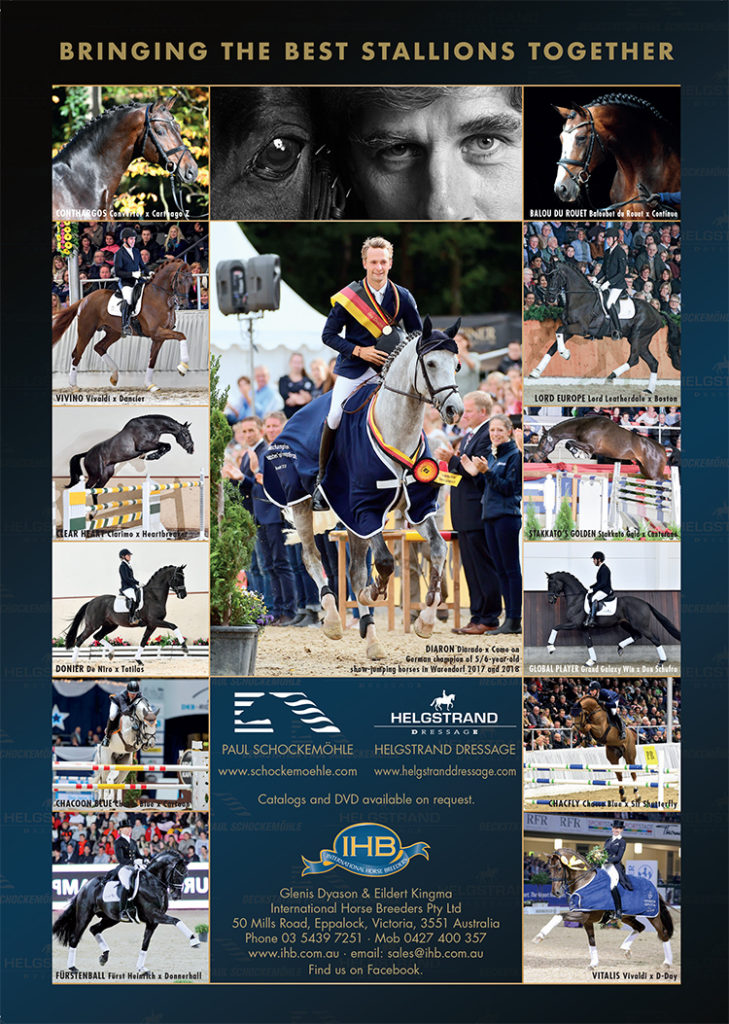
Can horses get so aversive to a particular form of jump, that you get to the point of no return?
“Horses can develop a phobia about water jumps and to a lesser extent Liverpools. I’ve seen it with walls with horses that have been Puissanced – they were brave, they went up to a metre eighty, two metres, whatever, and eventually they’ve chucked it in, or crashed through it. I’ve seen horses in that situation take a strong aversion to a wall, and they won’t even come back to Table A and jump a metre fifty wall.”
“The wall is something that is very recognizable, and if the horse is aversive to it, he’ll spot it. I have seen horses, that are very confident brave jumpers, that have been through an unpleasant Puissance experience, and they chuck it in at walls. Certainly Liverpools and open waters, are similarly recognizable – especially the open water. There are probably four or five horses competing at Grand Prix level in Australia, that you can guarantee if you build a course with an open water in it, they are not going to jump it – and yet they are highly competitive in every other way.”
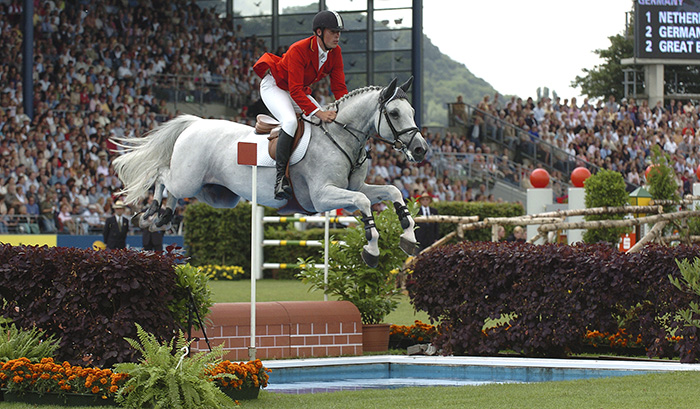
Have you had horses that you could never get their confidence over a particular obstacle again?
“I’ve had one Grand Prix horse who had a water issue, that I didn’t give up on but he was never entirely right. We sort of got to a stage where he might jump it, that was as good as we got. But he went from a situation where he absolutely wouldn’t jump it, so I guess there was progress.”
How did you do that?
“Total persistence. Thorough thorough thorough preparation – every time I went into the ring with him when there was a water jump, I snuck off to the back of the showgrounds, behind the stables, somewhere, put a tarpaulin out, a plastic sheet – walked him over it, stood him on it. That I found was probably the best preparation.”
Flogging them is not the answer?
“Not with this horse, it was totally counter productive. He would stop thirty strides away if you pulled the baton. The only way to get him to jump it was to canter down to it like you were cantering to a metre thirty vertical. Soon as you pressured him, clucked him, moved him up, he immediately sucked back and wouldn’t go. There was a chance if you just cantered down to it and he had a nice preparation, there was just a chance he might jump it. It was pretty un-nerving in the big Grand Prix to deal with that, but in every other respect he was just a fantastic horse.”
story continues below advertisement

“The other aspect of the water jump is, apart from the jump itself, because really the jump itself is not such a big deal, if the horse is confident to go to it, the major issue is clearing the back line. We’ve only talked about one aspect of the water, where the horse might have an aversion to it. Most horses are prepared to jump it, but they may not get to the tape and they’ll have four faults. That can be a very frustrating issue because some horses not only don’t have an aversion to water, they don’t give a rat’s arse about it. They have landed in one or two, they know it is not very deep, and they don’t really make much of an effort.”
“If you have that problem, when you school over open water, you school with a rail half way along – maybe a metre high. You want the horse to leave the ground with purpose and momentum, then he is going to make it to the other side. But if he is weak when he leaves the ground and is looking, then he’ll probably jump in it, or if he doesn’t bother jumping up high, and he just jumps out a little bit but he’s not really concerned about it, then chances are he’ll fault every time. They have got to have sufficient respect.”
“I sometimes wonder if open water really tests what a showjumper is about because I’ve seen wonderful jumpers who just don’t give a toss about water and they never win the major championships because they are the classes that have the water. As a result people try all sorts of fairly ruthless things for those horses that don’t make much of an effort to jump water because they know it is not going to hurt them.”
“Obviously training with a rail over the top encourages the horse to jump up higher, and you are going to hope that when he gets to the next water jump he is going to think of jumping high. At the same time jumping a metre fifty doesn’t necessarily make the horse jump a metre twenty any better. When it is a metre fifty he jumps a metre fifty, when it is a metre twenty he just jumps a metre twenty as well. I’m not sure the rail over the water works, in my experience they jump it high when the rail is there and they jump it low when the rail is not, but you hope it will encourage them to jump out.”
“Then just as people try to get horses more careful jumping over poles by active or passive rapping, they might try to get the horse tuned to water – I’ve heard of all sorts of things, like fishing line stretched over the jump – the horse can’t see it but if he jumps a little low he is going to twang the fishing line. I don’t think that hurts them, it doesn’t tip them over, it is just a little surprise, and it may just make him think, ‘what was that?’ and jump a little higher the next time. Technically, it is against the rules, but as a training method I would favour that in front of the other method I’ve heard of – where people put petrol over the water and throw a match as the horse is leaving the ground! I haven’t seen it, it might be an urban myth.”
“But I have seen people dig deep holes and put the old timber fruit boxes in the hole, and the rubber on top of that, so if the horse jumps in it is going to collapse under him and give him a fright. I’ve seen one very famous, old Australian showjumping rider throw his groom on a very frustrating horse – it was the best horse in the country by a street but it would jump into the water every time – he was a bit of a lateral thinker and he got a big rubber sheet as the water jump, and he tied it with a wire rope to the tow bar of his truck, and he had the groom cantering in, he was looking out the window of his truck, and as the horse left the ground, he drove off, so as it landed the sheet was moving and it pulled the rubber out from below him. I’ve seen some interesting things getting horses to jump water.”
“What you are doing when you do that sort of thing is playing the balance of caution and confidence, which is what professional riders do all the time. Fine tuning the balance of caution and confidence…”
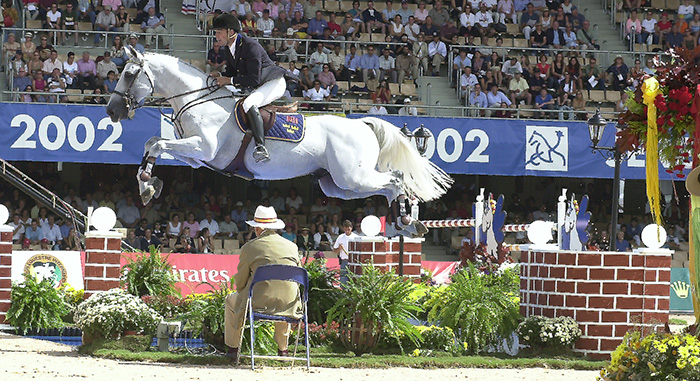
Next we look at combinations…


